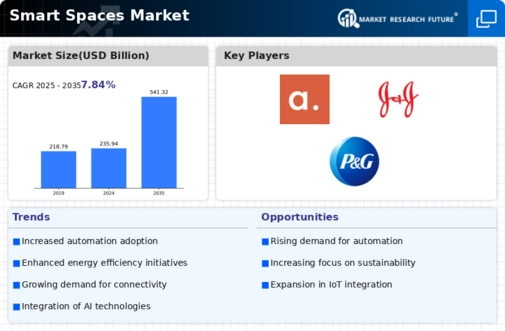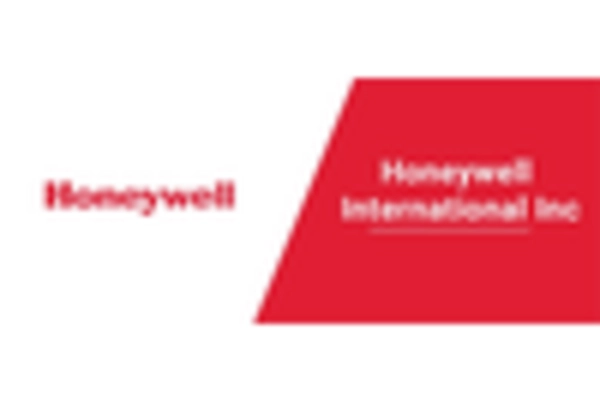-
Executive Summary
-
Market Attractiveness Analysis
- Global Smart Space Market, by Component
- Global Smart Space Market, by Application
- Global Smart Space Market, by Premise Type
- Smart Space Market, by Region
-
Scope of the Report
-
Market Definition
-
Scope of the Study
-
Market Structure
-
Market Research Methodology
-
Research Process
-
Primary Research
-
Secondary Research
-
Market Size Estimation
-
Forecast Model
-
List of Assumptions
-
Market Insights
-
Industry Overview of the Global Smart Space Market
-
Introduction
-
Drivers
- Drivers: Impact Analysis
-
Restraints
- Restraints: Impact Analysis
-
Opportunities
-
Market Factor Analysis
-
Porter’s Five Forces Analysis
- Threat of New Entrants
- Bargaining Power of Suppliers
- Bargaining Power of Buyers
- Threat of Substitutes
- Segment Rivalry
-
Value Chain/Supply Chain of the Global Smart Space Market
-
Global Smart Space Market, by Component
-
Introduction
-
Solutions
- Market Estimates & Forecast, 2020–2027
- Market Estimates & Forecast, by Region, 2020–2027
-
Services
- Professional Services
- Managed Services
-
Global Smart Space Market, by Premise Type
-
Introduction
-
Commercial Areas
- Market Estimates & Forecast, 2020–2027
- Market Estimates & Forecast, by Region, 2020–2027
-
Residential Areas
- Market Estimates & Forecast, 2020–2027
- Market Estimates & Forecast, by Region, 2020–2027
-
Others
- Market Estimates & Forecast, 2020–2027
- Market Estimates & Forecast, by Region, 2020–2027
-
Global Smart Space Market, by Application
-
Introduction
-
Energy Management and Optimization
- Market Estimates & Forecast, 2020–2027
- Market Estimates & Forecast, by Region, 2020–2027
-
Emergency Management
- Market Estimates & Forecast, 2020–2027
- Market Estimates & Forecast, by Region, 2020–2027
-
Security Management
- Market Estimates & Forecast, 2020–2027
- Market Estimates & Forecast, by Region, 2020–2027
-
Global Smart Space Market, by Region
-
Introduction
-
North America
- Market Estimates & Forecast, by Country, 2020–2027
- Market Estimates & Forecast, by Component, 2020–2027
- Market Estimates & Forecast, by Application, 2020–2027
- Market Estimates & Forecast, by Premise Type, 2020–2027
- US
- Canada
- Mexico
-
Europe
- Market Estimates & Forecast, by Country, 2020–2027
- Market Estimates & Forecast, by Component, 2020–2027
- Market Estimates & Forecast, by Application, 2020–2027
- Market Estimates & Forecast, by Premise Type, 2020–2027
- Germany
- France
- UK
- Rest of Europe
-
Asia-Pacific
- Market Estimates & Forecast, by Country, 2020–2027
- Market Estimates & Forecast, by Component, 2020–2027
- Market Estimates & Forecast, by Application, 2020–2027
- Market Estimates & Forecast, by Premise Type, 2020–2027
- China
- India
- Japan
- Rest of Asia-Pacific
-
Middle East & Africa
- Market Estimates & Forecast, by Component, 2020–2027
- Market Estimates & Forecast, by Application, 2020–2027
- Market Estimates & Forecast, by Premise Type, 2020–2027
-
South America
- Market Estimates & Forecast, by Component, 2020–2027
- Market Estimates & Forecast, by Application, 2020–2027
- Market Estimates & Forecast, by Premise Type, 2020–2027
-
Company Landscape
-
Competitive Overview
-
Competitor Dashboard
-
Major Growth Strategies in the Global Smart Space Market
-
Competitive Benchmarking
-
Vendor Share Analysis
-
XXXX: The leading player in terms of number of developments in the Global Smart Space Market
-
Key Developments & Growth Strategies
- Product Launches/Service Deployment
- Mergers & Acquisitions
- Joint Ventures
- Business Expansion
-
Company Profiles
-
ABB.
- Company Overview
- Product/Business Segment Overview
- Financial Updates
- Key Developments
- Key Strategies
-
Cisco Systems Inc.
- Company Overview
- Product/Business Segment Overview
- Financial Updates
- Key Developments
- Key Strategies
-
ICONICS, Inc.
- Company Overview
- Product/Business Segment Overview
- Financial Updates
- Key Developments
- Key Strategies
-
Coor.
- Company Overview
- Product/Business Segment Overview
- Financial Updates
- Key Developments
- Key Strategies
-
Siemens AG
- Company Overview
- Product/Business Segment Overview
- Financial Updates
- Key Developments
- Key Strategies
-
FASEAS SPACEWELL
- Company Overview
- Product/Business Segment Overview
- Financial Updates
- Key Developments
- Key Strategies
-
Eutech Cybernetic Pte. Ltd
- Company Overview
- Product/Business Segment Overview
- Financial Updates
- Key Developments
- Key Strategies
-
Huawei Technology Co Ltd
- Company Overview
- Product/Business Segment Overview
- Financial Updates
- Key Developments
- Key Strategies
-
Schneider Electric
- Company Overview
- Product/Business Segment Overview
- Financial Updates
- Key Developments
- Key Strategies
-
Smarten Spaces.
- Company Overview
- Product/Business Segment Overview
- Financial Updates
- Key Developments
- Key Strategies
-
Smart Space Software Plc
- Company Overview
- Product/Business Segment Overview
- Financial Updates
- Key Developments
- Key Strategies
-
Hitachi Vantara Corporation
- Company Overview
- Product/Business Segment Overview
- Financial Updates
- Key Developments
- Key Strategies
-
Ubisense
- Company Overview
- Product/Business Segment Overview
- Financial Updates
- Key Developments
- Key Strategies
-
Adappt
- Company Overview
- Product/Business Segment Overview
- Financial Updates
- Key Developments
- Key Strategies
-
LIST OF TABLES
-
Global Smart Space Market, by Region, 2020–2027
-
North America: Smart Space Market, by Country, 2020–2027
-
Europe: Smart Space Market, by Country, 2020–2027
-
Asia-Pacific: Smart Space Market, by Country, 2020–2027
-
Middle East & Africa: Smart Space Market, by Country, 2020–2027
-
South America: Smart Space Market, by Country, 2020–2027
-
Global Smart Space Component Market, by Region, 2020–2027
-
North America: Smart Space Component Market, by Country, 2020–2027
-
Europe: Smart Space Component Market, by Country, 2020–2027
-
Table10 Asia-Pacific: Smart Space Component Market, by Country, 2020–2027
-
Table11 Middle East & Africa: Smart Space Component Market, by Country, 2020–2027
-
Table12 South America: Smart Space Component Market, by Country, 2020–2027
-
Table13 Global Smart Space Application Market, by Region, 2020–2027
-
Table14 North America: Smart Space Application Market, by Country, 2020–2027
-
Table15 Europe: Smart Space Application Market, by Country, 2020–2027
-
Table16 Asia-Pacific: Smart Space Application Market, by Country, 2020–2027
-
Table17 Middle East & Africa: Smart Space Application Market, by Country, 2020–2027
-
Table18 South America: Smart Space Application Market, by Country, 2020–2027
-
Table19 Global Smart Space Premise Type Market, by Region, 2020–2027
-
Table20 North America: Smart Space Premise Type Market, by Country, 2020–2027
-
Table21 Europe: Smart Space Premise Type Market, by Country, 2020–2027
-
Table22 Asia-Pacific: Smart Space Premise Type Market, by Country, 2020–2027
-
Table23 Middle East & Africa: Smart Space Premise Type Market, by Country, 2020–2027
-
Table24 South America: Smart Space Premise Type Market, by Country, 2020–2027
-
LIST OF FIGURES
-
Global Smart Space Market Segmentation
-
Forecast Methodology
-
Porter’s Five Forces Analysis of the Global Smart Space Market
-
Value Chain of the Global Smart Space Market
-
Share of the Global Smart Space Market, by Country, 2020 (in %)
-
Global Smart Space Market, 2020–2027
-
Sub-Segments of Type
-
Global Smart Space Market Size, by Component, 2020
-
Share of the Global Smart Space Market, by Component, 2020–2027
-
Global Smart Space Market Size, by Application, 2020
-
Share of Global Smart Space Market, by Application, 2020–2027
-
Global Smart Space Market Size, by Premise Type, 2020–2027
-
Share of Global Smart Space Market, by Premise Type 2020–2027


















Leave a Comment